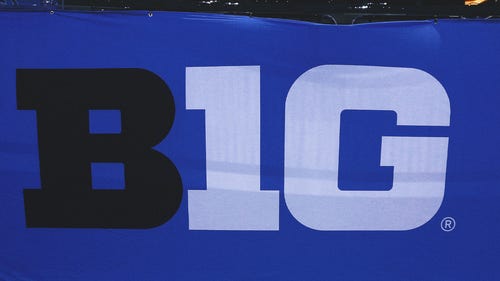
Oregon's Dillon Brooks ready to assert himself in star-studded Midwest Regional
KANSAS CITY, Mo. — Dillon Brooks finished his conversation, laid his cell phone on his bag, exchanged pleasantries with a visitor to his Sprint Center locker stall and soon declared he was having the best basketball season of his life. “Sometimes you have to go through a little to get to where you’re at now,” Oregon’s leading scorer said. “Those things shaped me.”
The offseason foot surgery, the drag of rehab, the three missed games to start the year, the frustratingly mercurial progress back to his former self, the blip of a foot sprain that caused him to sit out another game in January…these are those things. Brooks is the Pac-12 Player of the Year. His team has made back-to-back Sweet 16 appearances for the first time in program history. He is not a candidate for alms.
He is also not a candidate for national player of the year honors, mostly due to circumstances out of his control. He might have been once upon a time. Oregon was a purported preseason national title contender and the 6’6” junior was its fulcrum. But the foot issues and the methodical recovery threw him too far off the pace. And so Brooks took his turn Wednesday practicing on the same floor occupied at other points by Purdue’s Caleb Swanigan and Kansas’s Frank Mason III, both of whom may be in line to collect the sundry trophies and plaques honoring the premier performer in all of college basketball.

Naturally, the Midwest Region semifinal between the Jayhawks and the Boilermakers is captivating at least in part because two viable national player of the year contenders will meet, if not match up. Dillon Brooks’s appearance against Michigan in the preceding game Thursday isn’t quite as tantalizing. But it has its own kind of meaning. The most important player on site this weekend might be the national player of the year that never was.
*****
If 6’9”, 250-pound power forward Caleb Swanigan and 5’11”, 190-pound point guard Frank Mason III actually find themselves matched up during their teams’ Sweet 16 contest, it’s likely that a very large mistake has occurred. The result will probably be very bad for either Purdue or Kansas. So neither of the two All-Americas here entertained the idea of facing each other with any great seriousness.
“I don’t really think about that,” Mason III said. “I just think about Kansas versus Purdue. It doesn’t really matter who they have in their team.”
“It’s just about Purdue over Kansas, is what I’m trying to get right here,” Swanigan said. “And he’s trying to get Kansas over Purdue. We’re both just trying to win a game. We all just want a championship more than anything.”
In this way Dillon Brooks is no different. When the ball tips Thursday, in the midst of that greatest year of his career, the Ducks star will not have forgotten that one of the worst nights of his life took place 362 days earlier. On March 26, 2016, Brooks scored seven points and collected five fouls as top-seeded Oregon was demolished by Oklahoma in the Elite Eight. “I played a terrible game,” he recalled Thursday. “I lost my mind.” He focused too much on getting himself going and failed. He didn’t exert any presence on the glass, grabbing one rebound. He hardly got anyone else involved, recording three assists, a tally that was simply not enough given the shortcomings everywhere else. “I was a liability on the floor,” Brooks said. “I never want to be a liability on the floor.”
That Brooks is vital to Oregon’s success is no newsflash. “He does everything for them,” Michigan guard Muhammad-Ali Abdur-Rahkman said. That Brooks might be the most valuable player in Kansas City is maybe less self-evident. It also might be true.
There is no player left in the NCAA tournament field who is involved in more of his team’s possessions. And Brooks’s usage rate of 30.9% outstrips that of Mason III (25.6%) and Swanigan (28.1%). By far, he leads all remaining players in percentage of shots taken, per kenpom.com; Brooks is at 33.4% and only two other players ranking in the top 100 nationally in that area, South Carolina’s P.J. Dozier and Butler’s Kelan Martin, remain active this week. And Brooks is also the most efficient high-involvement producer left: Of Sweet 16 players using at least 28% of their team’s possessions, Brooks’s offensive rating of 115.3 leads the way. Swanigan is third at 113.4, and Mason III only jumps ahead of both with a 124.2 rating if the usage threshold drops to 24%.

Clearly, Brooks is essential to Oregon playing well. Beyond that, though, he is essential to how Oregon wants to play.
Among the remaining NCAA tournament teams, Oregon ranks fourth in three-point reliance (32.6% of its shots are from long range) and first in percentage of shots taken at the rim (42.5%). There is seemingly little in-between with the Ducks’ offensive philosophy, an approach mirrored (not shockingly) by its most dominant offensive personality. Brooks ranks second among Oregon players with both 6.5 three-point attempts per 40 minutes and a total of 139 shot attempts at the rim. “He’s such a matchup problem,” Oregon senior guard Dylan Ennis said. “He can play three, he can play four, he brings the ball up sometimes. He can do everything. It’s not just that he’s scoring points. He’s getting rebounds, he’s blocking out, he’s communicating on the floor. I can’t find a more complete player in the country than Dillon Brooks.”
*****
It’s insane, of course, to diminish the importance of Swanigan and Mason III to their respective teams.
Mason III currently is tied for fifth nationally with 7.0 Win Shares and Swanigan sits at 14th with 6.4. Kansas has a super-charged attack because Mason III sets the pace, and the senior has logged the highest percentage of minutes (89.2%) of anyone left in the tournament. Purdue has a top 20 defense because Swanigan anchors it, and it shoots a high rate of three-pointers in part because its standout sophomore draws attention in the lane. (Though Swanigan is also a 43.2% shooter from beyond the arc to boot.) “I just know we wouldn’t be here without him,” Purdue forward Vince Edwards said.
“We have a lot of things other teams don’t have,” Kansas freshman Josh Jackson said. “For one, we have Frank Mason.”
So let’s just leave it at this: Dillon Brooks is as inextricably woven into Oregon’s operation as any player in the country. He also enters Thursday averaging 18.4 points over his last 14 games, eight of which have been 20-point outings. Ducks guard Tyler Dorsey was irrepressible in the team’s first two NCAA tournament games—scoring 51 points combined—but Brooks has been the more preeminent force over the long haul. “I always think I’m the best player in the NCAA,” Brooks said. “I play like that. I play my hardest and let the chips fall where they may.”

When they meet late Thursday, Kansas and Purdue will deploy two stars inarguably playing at a level few in the country have reached. And a couple hours before that, an Oregon forward will return to the locker room during warmups and drape a towel over his head. Dillon Brooks began this ritual in February after reading the book Mindfulness. It helped him clear his head and narrow his focus. “I felt no pressure, I felt no anxiety, just played the game freely,” Brooks said.
He dropped 27 points on Arizona State that winter night. That’s when his late-season tear began. That’s when Dillon Brooks started looking like a national player of the year that might have been.










